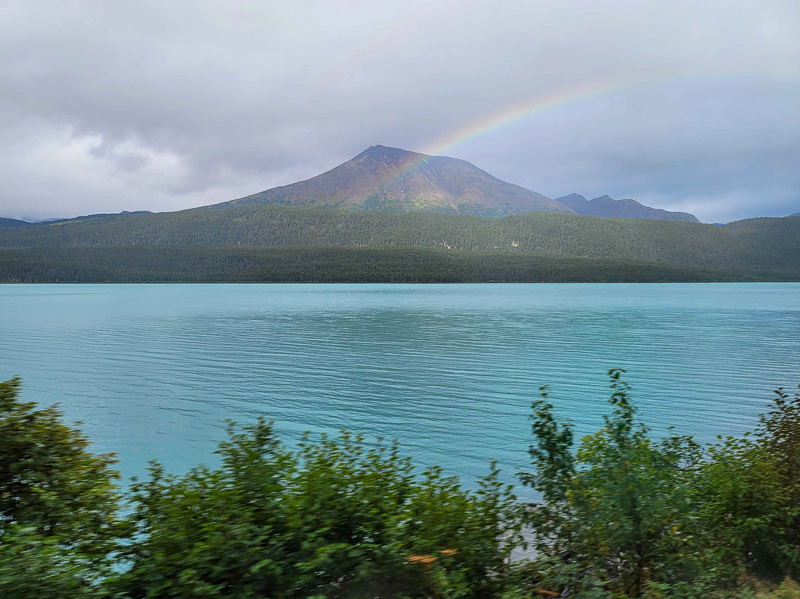One of the biggest draws to Alaska is its unparalleled natural scenery, and Turnagain Arm is one of the most beautiful—and potentially dangerous—places to visit near Anchorage. Turnagain Arm is a waterway that empties into the northwest portion of the Gulf of Alaska, and it is one of two branches of Cook Inlet that are known for their extreme tide ranges, dangerous mud flats, and stunning views.
About Turnagain Arm
Arguably one of the most beautiful stretches of American highway, Turnagain Arm can be seen from Seward Highway that hugs its dramatic shorelines. With some of the largest tides in the country, the waters of Turnagain Arm can rise 40 feet at high tide—with low tide exposing expansive mud flats cut by stream channels.

Photo our team snapped at Turnagain Arm
Getting to Turnagain Arm
The Seward Highway (AK-1) runs parallel to Turnagain Arm, providing easy access from Anchorage. This route is designated as a National Scenic Byway, celebrated for its stunning coastal and mountain views.
Our Turnagain Arm tours include scenic wildlife tours and transfers between Anchorage and Seward, perfect for cruise travelers.
Turnagain Arm Highlights
- Scenic Drive: The Seward Highway offers numerous pullouts and viewpoints where travelers can stop to admire the dramatic landscapes, towering mountains, and tidal flats of Turnagain Arm.
- Beluga Point: A popular roadside stop, Beluga Point provides opportunities to spot beluga whales during their seasonal migrations, especially in late summer and early fall.
- Bird Point: This rest area features interpretive signs, boardwalks, and viewing platforms, making it an excellent spot for photography and wildlife observation.
- Bore Tide: Turnagain Arm experiences one of the world's largest bore tides, a dramatic wave that rushes in during low tide. Timing your visit to witness this natural phenomenon is a unique experience.
Wildlife Viewing
Turnagain Arm is home to a variety of wildlife:
- Beluga Whales: Often seen near the shorelines, especially around Beluga Point.
- Dall Sheep: Frequently spotted on the cliffs above the highway.
- Birds: Eagles, gulls, and migratory birds are abundant, particularly in the spring and fall.
Tips for Visiting Turnagain Arm
- Tide Awareness: Be mindful of the tides, especially if exploring tidal flats, as the water levels can change rapidly.
- Safety: Stay on designated trails and be cautious near cliffs and wildlife.
- Weather Preparedness: Weather can change quickly; dress in layers and be prepared for rain or shine.
Geography & History
Turnagain Arm was named as a result of an expedition party in 1778 that was on a mission to find the Northwest Passage. William Bligh led a part up Turnagain Arm only to report back that it led to a river—in frustration, the Bligh named the body of water “Turnagain River”.
Turnagain Arm flows east to west and is over 40 miles long, forming part of the Kenai Peninsula’s northern border. The rugged terrain surrounding Turnagain Arm is framed on the left by the 3,000 foot mountains of Chugach State Park. Glaciers can still be found dotting the U-shaped valleys of the Turnagain Arm area, including Portage Glacier, Explorer Glacier, and Skookum Glacier.
Interesting Facts
Turnagain Arm is stunning from a distance, but it holds dangerous secrets that can be a hazard for unaware visitors. With plenty of local legends, tragic accidents, and a storied past, Turnagain Arm is worth the drive—just be careful about getting too close!
- In the top of the highest tides in North America, Turnagain Arm’s 40-foot high tide can come in so quickly that it produces a bore tide—a wave of water that ushers in the rising waters.
- Extreme sport enthusiasts have been known to take advantage of the bore tides by kayaking and surfing the waves as they roll in.
- In 1964, an Alaskan earthquake destroyed the former settlement of Portage at the head of Turnagain Arm.
- Many have lost their lives in Turnagain Arm from disasters that include a 1920 avalanche, windsurfing accidents, plane crashes, and drowning in the quicksand mud flats.
- The Cook Inlet around Turnagain Arm averages one search and rescue operation a week due to accidents with planes, boating, or swimming.
- Both gold placers and gold quartz lodes have been found in the mineral resources of the Turnagain Arm area.
Final Thoughts
Visiting Turnagain Arm offers a blend of natural beauty, wildlife encounters, and unique experiences that showcase the splendor of Alaska's landscapes.
Check out our Turnagain Arm tours or view all of our Anchorage tours.

